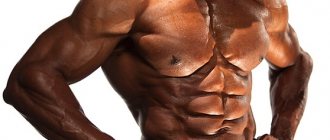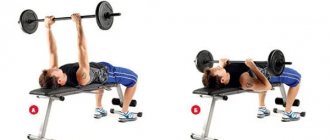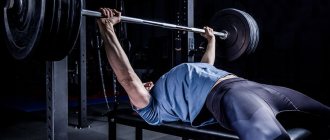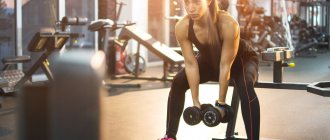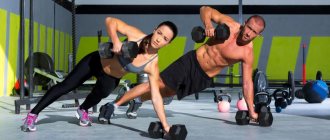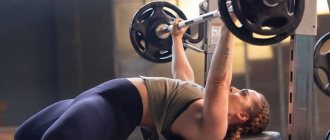The beach season is about to begin, but the reflection in the mirror is not ready for it yet? Become a sex symbol of the coming summer and boldly flaunt your muscular body and pumped-up breasts on the beach.
Pumping up the pectoral muscles, especially at the end of spring, is a sore point for most men. If you are one of them, don't worry - it's normal. The main thing is to catch yourself in time and start doing exercises for the upper chest. By the way, they are very different, but we will focus on those that will allow you to pump up your pectoral muscles in record time.
The problem of a “lagging top” is common - and not only among mere mortals, but also among real bodybuilders. Sometimes athletes do not know or ignore the fact that the muscles of the upper, middle and lower chest are different things and they should be worked differently.
Bench press on a bench with a slight incline (30 to 45 degrees) is often chosen as an exercise for the upper chest, which is not correct .
The reason is simple - this upper chest exercise is only 5% more effective than the flat bench press. In this case, the entire main load is given to the deltoid muscles, the load of which increases to 85%.
Exercises to pump up the upper chest
To pump up your upper chest, you need to learn 6 exercises:
- Bench press at different angles.
- Dumbbell raises at 30 and 45 degree angles.
- Press dumbbells at the same angles.
- Bringing your arms together in a crossover (arms above parallel).
- Dips. This exercise is more focused on working the lower chest and outer part, but don't let that fool you. We will do it, as it is very effective for complex muscle development.
- Push-ups from the floor upside down.
Home workout
Training the pectoral muscles itself is very energy-intensive, so many people also use it to burn excess fat.
A person often comes up with a large number of different excuses for himself why he cannot train and go to the gym.
Usually everything is attributed to workload, frequent business trips, inconvenient location or embarrassment to work with someone nearby and be constantly in sight.
But this should not become a reason to deny yourself the pleasure of becoming the owner of a beautiful and athletic figure.
Therefore, most people prefer exercising at home. In this case, it is not the place that is important, but the perseverance and determination of the person.
Previously, we talked about how to pump up your breasts.
Correct technique for performing each exercise
Before training, do not forget to warm up and pre-stretch!
Barbell bench press
We will need an incline bench, barbell racks and the barbell itself. The exercise can be done at home. Here the weights are not as heavy as in the case of the classic bench press.
The first approach will be a warm-up with an empty bar (its weight is about 20 kg - for girls this is a lot, for guys it’s just right):
- Set the inclination of the bench back to 30 degrees. We lie down so that the barbell is exactly above our eyes.
- We grab the bar with our hands wider than our shoulders. The grip width is determined as follows: lower your arms from this position with your elbows down, the angle between the forearm and shoulder should be about 90 degrees. The grip is circular, there is no need for any one-sided grips where the bar could roll onto your stomach.
- We rest our feet on the floor. Raise the bar to the maximum possible straightening of your arms and lower it onto your neck. It was a breath.
- As you exhale, return it to the top point. Do 15 reps with an empty bar, then begin working sets.
If you are a girl, take a lighter bar. For you, dear ladies, there will always be bars weighing 4, 6, 8 kg, etc. They are rubberized and multi-colored.
The nuances that cause errors to occur:
- Do not lift your pelvis during the exercise. He is “glued” to the bench.
- The chest is slightly curved forward, there is a natural deflection in the lower back. There is no need to do any bridges, otherwise you will turn your body into the classic press position. The meaning of the tilt is lost.
- The legs are spread and the heels rest on the floor. It happens that beginners, having watched enough strange video tutorials on “how to build muscles,” keep their legs suspended. At any moment they can fall to one side of the bench. We understand that they also want to pump up their abs, but this is done separately. Without a barbell.
- We perform it smoothly, without jerking.
- Lower the barbell to the neck area. Not on the chin or chest. It is important for us to work the upper part of our pectoral muscles!
- We don’t take our heads off the bench. We look up, not left and right.
- Always lock the barbell. If during training the pancake falls or slides onto the edge of the bar, the approach will be wasted.
We select the working weight so that it is hard to work, only in this case we will be able to pump up something. We do this version of the exercise after the classic bench press, or on our own - 3-4 sets of 8-10 repetitions. We approach working weight gradually. If necessary, we call a partner to back up.
Dumbbell flyes
We set the same angle of the bench. We lie down on it in the same way as when doing a barbell press:
- The movement of dumbbells occurs in a plane perpendicular to the floor. Elbows point down.
- We stretch as much as possible, lowering our arms with dumbbells.
- The arms are slightly bent during the movement and almost straighten at the top point (there is no need to bend them to 90 degrees; you cannot do the exercise with straight arms).
We spread our hands as we inhale, and bring them together as we exhale. The weight should be such that you can do 3 sets of 12 reps with correct technique.
Dumbbell press
This is where disagreements arise. Some trainers suggest doing the same thing as with a barbell, but with dumbbells. Others say that you need to move your elbows a little closer to the body to increase the load on the front deltoids.
We offer a compromise: Move your elbows a little closer to your body from your angled bench press position. We do 3-4 sets of 10 times.
Bringing hands together in crossover
Perhaps the most technically difficult exercise:
- We install the necessary handles so that it is comfortable to hold with your hands.
- We stand between them. We take the handles with our palms forward and bring them together on slightly bent arms at chest level.
- Here is the nuance - if you lower your arms, it will no longer be the top of the pectoral muscles that will work.
- Your hands should be slightly behind each other at the final point of reduction, as if you had crossed them.
The exercise is a little easier than the version with dumbbells, so here you can perform a little more repetitions - 3-4 sets of 10-12 times.
Dips
The warm-up approach should be without weight. If possible, move the bars so that the distance between them is about 10 cm wider than your shoulders on each side.
The nuance is this: when doing push-ups, we do a “boat”. That is, we tilt our legs back. When moving from bottom to top, you seem to emerge from under the water. This will shift the load from below to the middle of the chest.
We do 3-4 approaches of 15 times without weight or the same number of approaches, but 8 repetitions with weights. If desired, you can make a ladder, reducing the number of repetitions from approach to approach, and increasing the weight.
Upside down push-ups
The most convenient option for breast lifting at home. Take a stool or sofa. We take a lying position, hands slightly wider than shoulders, fingers pointing forward. We put our feet on a stool.
This way you are standing in an inclined position. Head below feet. We do 3-4 sets of 10-15 times. If you can do more, do it. It doesn’t matter, it’s still without any burden.
We go down as we inhale, we rise as we exhale. Our chin almost touches the floor.
How to choose a mode for sports?
First of all, you need to remember: you cannot pump your upper chest every day.
This can give the opposite result and only harm your figure.
When a person begins to actively engage in sports, muscle fibers receive microtrauma as a result of training.
It takes time for them to recover. During rest, protein is produced and new muscle mass begins to form.
The most optimal regimen is 1-2 workouts per week.
At the same time, you should not overload yourself during these exercises, that is, all exercises should be limited to 4-8 approaches.
For beginner athletes, this figure should not be more than 2-3 repetitions.
Exercise combinations
We have given you an example of 6 different exercises for pumping up the upper chest area. Naturally, there is no need to do them in one day. When you work “to failure” you will simply become overtired, and there is no point in such training. Therefore, to conscientiously pump up your upper chest, choose three exercises per workout:
- Bars, angled press, angled fly.
- Angle press, dumbbell press, dumbbell fly.
- Press, fly, crossover.
Do push-ups on your own to pump up your chest at home.
Don't forget to do warm-up sets! By the way, you can alternate dilutions of 30 and 45 degrees.
What are the muscles in the chest?
The pectoral muscles are also called pectoral muscles. They consist of a group of symmetrical muscles.
Each such group includes the following muscles:
- Large chest.
- Small chest.
- Anterior serratus.
The first two muscles are responsible for allowing a person’s arms to bend at the shoulder joint. In addition, thanks to them, the arms are partially rotated inward.
The human chest can be divided into several sections, which include the upper, middle and lower sections.
In addition, there is also an internal part. She can also be pumped up.
The muscles in the middle section are always actively working and therefore pump up quite quickly.
But the lower and upper parts of the chest require a special approach. Targeted training is important here to help pump up the chest in these parts.
Incline Dumbbell Flyes
Many professional athletes recommend using this exercise as a “finisher” after incline presses. Since the fly is done at the end of the chest workout, the weight of the dumbbells should be less than what you used during the press.
- Take the starting position: the projectiles should be at the top in front of you, and your arms should be slightly bent at the elbow joint.
- Inhaling, spread the dumbbells out to the sides, feeling the stretch as much as possible.
- As you exhale, lift them to their original position.
Anatomy
The pectoralis major muscle is a large fan-shaped muscle that is located almost throughout the chest. The fan converges at the humerus and includes the clavicular, sternocostal and abdominal heads.
It is the sternocostal zone that largely determines the appearance of the top. Due to the insufficient development of these fibers, the appearance of a flat chest is created in athletes who spend a lot of time on exercise machines.
For girls, exercises on the upper chest will bring no less benefit, since the upper beautiful zone is created and the breasts are raised. Broad shoulders visually add slimness.
Recommendations for beginning athletes
You already know how you can pump up your upper pectoral muscles at home or in the gym. Below are some important tips that will help you achieve your desired results faster.
- Don't train your chest too often. One of the most common mistakes among beginners is training too often. Beginning athletes naively believe that the more often they exercise, the faster their muscle mass will grow. In fact, this approach will not only not speed up muscle growth, but, on the contrary, will slow it down significantly. In order for your pecs to grow and your working weights to increase, you need to recover. This applies not only to the pectoral muscles, but also to the muscles of the whole body.
- Breathe correctly. Breathing is an important training aspect that will determine how many repetitions you can do in one set. Remember that in the positive phase of the exercise you need to exhale, and in the negative phase you need to inhale.
- Pay attention to technology and safety. Before you start doing any exercise that is new to you, study its technique in detail. If you feel that the selected working weight is very difficult for you, reduce it to avoid injury. Remember to warm up thoroughly before each training session to prepare your muscles and joints for subsequent strength loads.
